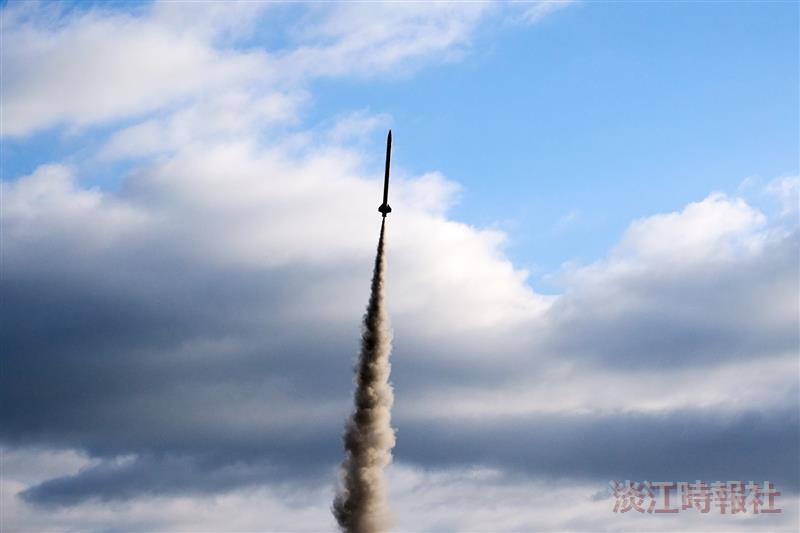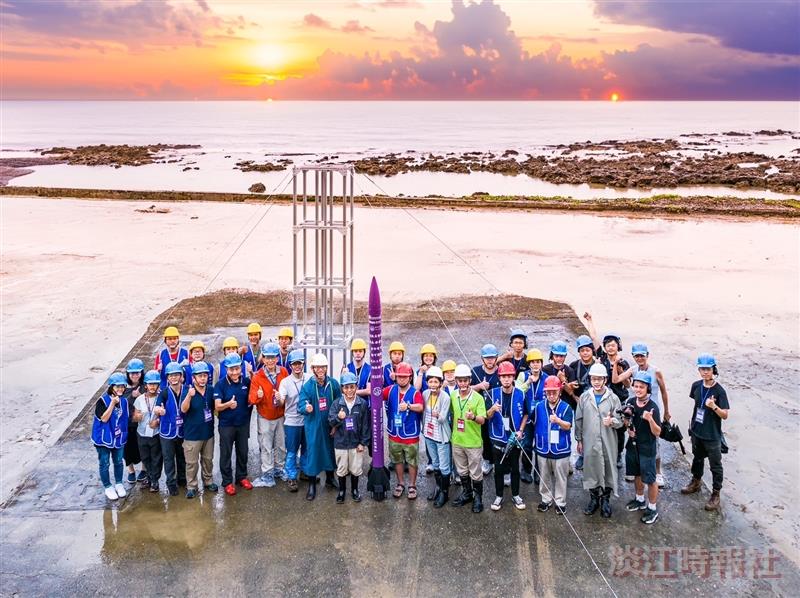News and Events
Launching Twice within 3 Months, Aerospace Department's Sounding Rocket Jessie Completed the Research Mission Successfully
Date 2023-09-11 1940 Clicks

On September 11th, at 6:49 a.m., the Department of Aerospace Engineering successfully launched the second research sounding rocket Jessie at the National Science and Technology Council (NSTC)'s "Short-Term Research Sounding Rocket Launch Site" in Hsuhai, Pingtung. This achievement marked the first team to complete two flights since the inauguration of the Hsuhai launch site. A delegation of 8 members from the Taiwan Transportation Safety Board (TTSB) also attended to observe this test launch.
Dr. Fu-Yuen Hsiao, Chair of the Department, stated that the initial scheduled launch for this test was on September 3rd but was postponed by a week due to the influence of Typhoon Haikui. Jessie had a propulsion duration of 7 seconds, reached a maximum altitude of 4.32 kilometers, meeting the mission objectives and further validating the execution capability of small-scale research rocket projects in academia. Our university had previously launched TK-I on June 5th, completing a mission at an altitude of 4,827 meters. Following the plan, we will conduct 2 more research payload missions. The structural vibration data collected by the payload instruments during this mission can be used as a reference for the analysis and vibration reduction of the upcoming full-scale rocket Polaris.
Dr. Hsiao explained that in June of this year, the research sounding rocket TK-I was successfully launched, verifying the university's rocket development and system integration capabilities. The communication and telemetry systems also worked well. Jessie, launched this time, is based on the TK-I and also uses the emerging solid propellant RNX for a single-stage rocket. The goal of Jessie was to further validate the structural design of scientific payloads and composite rocket bodies, aiming for an altitude of 4.2 kilometers, with the addition of a parachute for rocket recovery. Dr. Hsiao expressed gratitude for the successful development of this rocket and thanked companies such as WK Automated Intelligence Co. LTD., Kuo Sen Enterprise Co., Ltd., SINBON Electronics, and Skwentex International Corp. for their technical and financial support. He particularly highlighted the assistance of WK Automated, the tail fin manufacturer, and Kuo Sen, the composite bonding manufacturer, for their support. Even in the face of strong winds during the rocket launch, both the rocket's structure and tail fins operated normally. "Both of these companies are alumni of the Aerospace Department, and they are very committed to the development of our alma mater, especially in supporting the research and development of sounding rockets."
Professor Yi-Ren Wang, the Principal Investigator of the Aerospace Department's research sounding rocket project, further explained that Jessie is built on the foundation of TK-I. In addition to using a lightweight composite material rocket body, it also includes increased mission payloads. This launch has verified that our laboratory has the basic capabilities in structural design and aerodynamic computational simulations. The composite production of the rocket body and its design met the requirements of this mission, and the tail fin bonding situation matched the expectations completely. Dr. Wang expressed gratitude for the assistance of the tail fin manufacturer and the composite bonding manufacturer. Even in the face of strong winds during the rocket launch, both the rocket's structure and tail fins operated normally. Unfortunately, due to continuous heavy rainfall causing moisture-related issues in the avionics system, the parachute did not deploy as planned. As for the payload measurement data, it is still under analysis.
Hsin-Cheng Ni, a third-year student in the Aerospace Department and the mission commander, explained that because the Tamsui team often jokingly refers to themselves as the Rocket Team, they decided to name the rocket after the leader of Team Rocket from Pokémon, whose English name is Jessie. Jessie has a total weight of 42 kilograms, a total length of 2.87 meters, and a maximum diameter of 13 centimeters. The maximum achievable flight altitude is 4.2 kilometers, with an average thrust of 2164 Newtons and a maximum thrust of 2898 Newtons. The burn time is 7 seconds, and the total impulse is approximately 15,000 Newton-seconds.
The space industry chain consists of four major domains: satellite manufacturing, space transportation, ground equipment, and satellite data applications. Dr. Jong-Shinn Wu, the Director General of the Taiwan Space Agency (TASA), stated that to address the gap in the Taiwanese space industry chain related to "space transportation," TASA has initiated a satellite launch vehicle development program with the support of government policies. Through research rocket projects commissioned by TASA, they have been continuously enhancing the rocket manufacturing capabilities within the academic community and fostering talent. In order to provide a legal and secure rocket launch site for domestic research and academia, the NSTC has established the "Short-Term Research Sounding Rocket Launch Site" in Hsuhai, Pingtung. TASA is responsible for reviewing usage applications and managing operations at this site. The Aerospace Department at our university not only possesses rocket manufacturing and launch technologies but is also actively involved in the National Cheng Kung University Lilium CubeSat constellation project. They are responsible for developing orbital control technology and are planning to launch it in 2025.
【News Dictionary】Payload refers to the objects carried by an aircraft or a launch vehicle. In this case, the payload includes a magnetic field measurement instrument, strain gauges, and accelerometers. The "magnetic field measurement instrument" is designed to measure changes in the magnetic field components of the rocket's environment during flight, while the "accelerometers" measure the rocket's vibration frequency. These two measurements are compared to verify the relative relationship between the rocket's vibration frequency and changes in magnetic field components. The "strain gauges" measure the amplitude of the rocket's vibrations to record the extent of its vibration. The relevant flight data recorded by these instruments will be provided for scientific analysis.
SDGs #SDG04 Quality Education #SDG09 Industry, Innovation and Infrastructure #SDG17 Partnerships for the Goals
LINKS
- PREV:Welcome Meeting for Overseas New Students: Diverse Introductions & Warm Reminders 2023-09-11
- NEXT:Risk Management & Insurance Department Alumna Shiu-Ling Huang Donates NT$ 20 million, Expecting to Award NT$ 200,000 to the Top Student in Each Grade 2023-09-18
- Crossing Seas for Exchange with Waseda University: Dr. Chiu-Kuei Tseng Visits Haruki Murakami 2024-04-08
- Formosa Scholarship Donor Visits President at School 2024-04-08
- TQM Seminar: Exploring New Chapters in Leadership Wisdom and Green Practices Together 2024-03-29
- Mass Communication Alumnus Chien-Hung Lien's Work Salli Wins Award in Osaka 2024-03-25
- 256 Young and Aged Volunteers Served at the Wan Jin Shi Marathon 2024-03-25
- North Tamsui USR Project: 10 Delicacies Revive Mackay’s Missionary Journey in Taiwan 2024-03-25
- Administrative Unit Digital Transformation and Net Zero Exhibition, President Keh Acknowledge Smart Initiatives for Sustainability 2024-03-25
- 2024 Net Zero Transition Alliance Summit: Inviting Alumni Enterprises to Collaborate in Cultivating Sustainability Talents 2024-03-16
- Alumni Reunion Spring Feast: Samuel Su and Jian-Fu Li Lead Singing of School Anthem, Andy Chen Donates NT$16.25 Million 2024-03-16
- Tamkang Shines at University Expo, Faculty and Students Unite in Recruitment Efforts 2024-03-11
